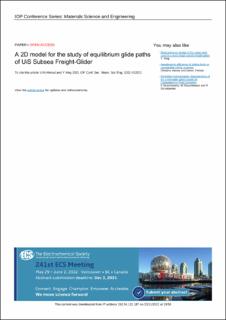| dc.contributor.author | Ahmad, Usman Nawaz | |
| dc.contributor.author | Xing, Yihan | |
| dc.date.accessioned | 2023-03-01T07:18:25Z | |
| dc.date.available | 2023-03-01T07:18:25Z | |
| dc.date.created | 2021-11-23T20:51:54Z | |
| dc.date.issued | 2021 | |
| dc.identifier.citation | Ahmad, U. N., & Xing, Y. (2021, November). A 2D model for the study of equilibrium glide paths of UiS Subsea Freight-Glider. In IOP Conference Series: Materials Science and Engineering (Vol. 1201, No. 1, p. 012022). IOP Publishing. | en_US |
| dc.identifier.issn | 1757-8981 | |
| dc.identifier.uri | https://hdl.handle.net/11250/3054810 | |
| dc.description.abstract | A planar mathematical model for the analysis of equilibrium glide paths of the UiS subsea freight-glider (USFG) is presented. The model is developed using Simscape Multibody in MATLAB/Simulink to study the ever-changing dynamics of the glider. Motion along the heave and pitch direction is regulated by two separate PID controllers. Controllers are tuned for the optimal bandwidth and phase margin to provide the system with ideal gains which satisfy the system requirements. A wide-ranging sensitivity investigation is carried out on the USFG by changing the two key variables, pump flow rate and ballast fraction. The results reflect the advantages of using higher flow capacity and ballast fraction, which should be preferred according to the application, provided if there are no space and weight restrictions. Finally, different glide paths were simulated to observe that, controller gains obtained from the linear model can be improved to acquire better performance in terms of robustness and stability of the system. | en_US |
| dc.language.iso | eng | en_US |
| dc.publisher | IOP Publishing | en_US |
| dc.rights | Navngivelse 4.0 Internasjonal | * |
| dc.rights.uri | http://creativecommons.org/licenses/by/4.0/deed.no | * |
| dc.title | A 2D model for the study of equilibrium glide paths of UiS Subsea Freight-Glider | en_US |
| dc.type | Peer reviewed | en_US |
| dc.type | Journal article | en_US |
| dc.description.version | publishedVersion | en_US |
| dc.rights.holder | The authors | en_US |
| dc.subject.nsi | VDP::Teknologi: 500 | en_US |
| dc.source.journal | IOP Conference Series: Materials Science and Engineering | en_US |
| dc.identifier.doi | 10.1088/1757-899X/1201/1/012022 | |
| dc.identifier.cristin | 1958162 | |
| cristin.ispublished | true | |
| cristin.fulltext | postprint | |
| cristin.qualitycode | 1 | |

